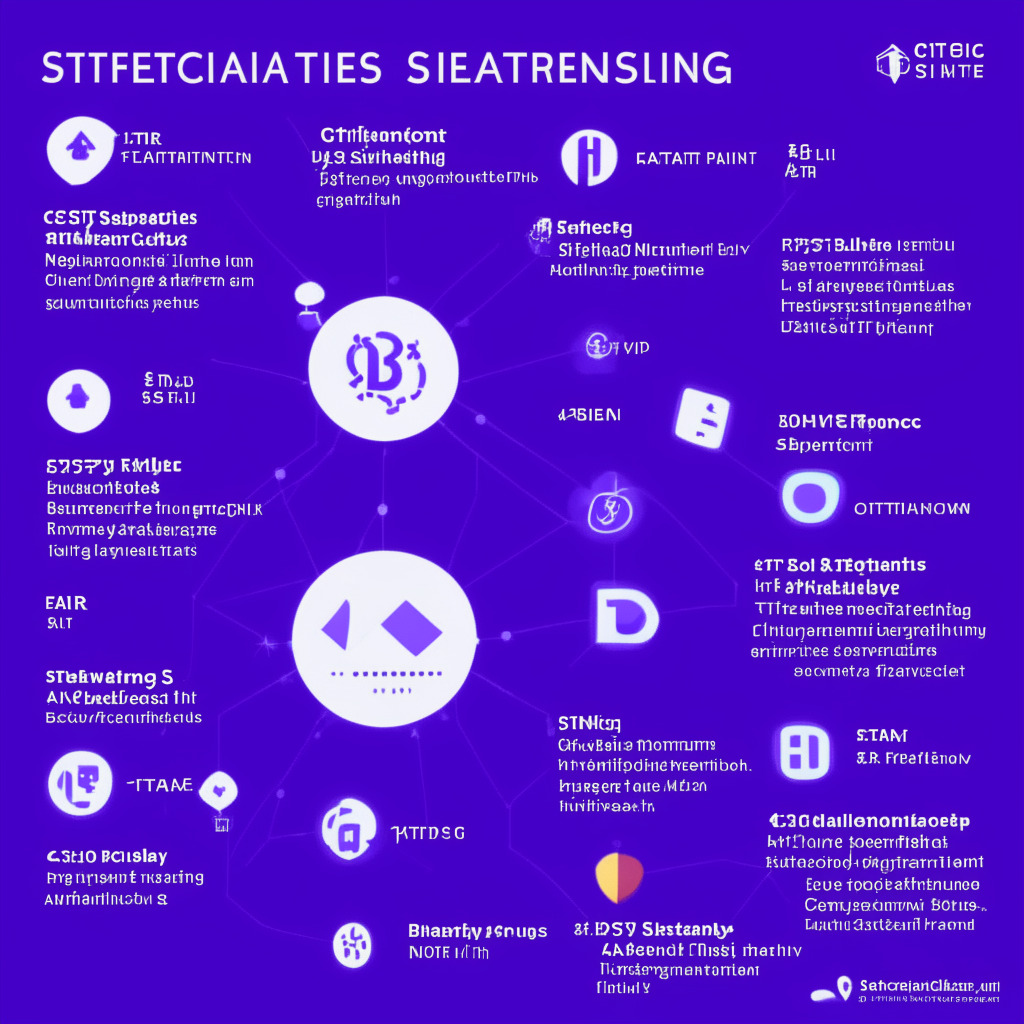The Ethereum network’s recent Shanghai upgrade enables validators to withdraw staked Ether (ETH), reducing gas fees and unlocking validator withdrawals. This upgrade impacts Ethereum app developers and users, enhancing blockchain functionality and potentially influencing institutional adoption of cryptocurrencies. The change may affect the number of network validators and ETH prices, depending on their decisions to unstake or invest further.
Search Results for: staked ether
Ethereum Staking Surge: Exploring Centralization Risks and Shrinking Yields
The rising staking of ether due to Ethereum upgrades sparks concerns over centralisation and lowered staking yields, according to a JPMorgan report. Despite decentralized platforms like Lido, risks tied to centralization and rehypothecation present security issues. This trend impacts the appeal of ether investment and emphasizes the evolving crypto market.
Ethereum’s Tussle with Resistance & Bitcoin Minetrix: New Cloud Mining Trend
“Ethereum’s marginal drop by 0.2% with a current standing 2.5% higher than two weeks ago suggests remaining uncertainty in the cryptocurrency market. Deepening ties with PayPal and Visa provide a boost, yet its breakthrough capacity remains unsure due to global financial stability.”
Ethereum Staking Shake-up: Buterin’s Insight and the Decentralization Dilemma
“Ethereum’s co-founder, Vitalik Buterin, discussed potential changes to Ethereum’s staking system, assessing a range of protocols and expressing concerns about the centralization of power among staking providers. He proposed mechanisms to enhance safety and decentralization of liquid staking and recommended revising certain procedures.”
Expanding Horizons: Ledn’s Ethereum Yield Product & Coinbase’s Regulatory Campaign
Ledn is introducing an Ethereum yield product in response to user demand for simpler staking alternatives. Their new offering is “ring-fenced,” providing a safety layer against bankruptcy. Ledn is also launching a stablecoin Growth Account, though not available in the U.S. or Canada. Meanwhile, Coinbase is seeking clearer crypto regulations, despite skepticism due to political and regulatory concerns.
Ethereum Market Dynamics: Potential Climb vs Increasingly Uncertain Terrain
“The Ethereum market exhibits dynamism, with ETH showing resilience after a drop and subsequent 6% rebound. Despite macroeconomic factors possibly boosting cryptocurrencies, concerns over high network fees, regulatory uncertainties and potential U.S. indictment of popular crypto exchange Binance, persist.”
Ethereum’s Proof-of-Stake Transition: A Year in Review and a Look into the Future
“Ethereum transitioned to the proof-of-stake system reducing power consumption by over 99% and making the network economically deflationary. However, anticipated price surge due to deflationary pressure hasn’t materialized swiftly. Liquid staking providers control significant amounts of staked Ether, raising potential centralization concerns.”
Revamping Ethereum’s Staking Infrastructure: Is SSV.network the Solution to Pool Decentralization and Key Security?
“SSV.network, in partnership with the Ethereum Foundation, recently launched its mainnet aiming to decentralize Ethereum staking pools. Leveraging Distributed Validator Technology, it aims to increase validator resilience, enhance private key security, and minimize the risks of validator downtime.”
Ethereum Staking Redefined: Decentralized Pathway Led by SSV Network Challenges the Norms
“ssv.network has introduced a blockchain solution emphasizing on liquid staking, aiming for a higher level of decentralization. Given the centralization concerns around Ethereum’s staking mechanism where top exchanges and selected entities hold majority of staked ETH, SSV’s mainnet proposes an approach to mitigate these problems. This new system, facilitated by SSV smart contracts, encourages multiple operators’ involvement without needing external coordination.”
Unraveling the Biggest Single Crypto Theft: A Cautionary Tale for Ethereum Wallet Holders
An individual recently lost around $24 million in cryptocurrency from his Ethereum wallet due to a phishing scam, marking one of the largest individual crypto thefts recorded. Security companies analyzing the incident emphasized the dangers of scams in the digital currency industry and underscored the essential need for strong, proactive security practices.
Shifting Sands: OnChainMonkey’s Bold Migration of NFTs from Ethereum to Bitcoin – A Glimpse into Future Trends?
“OnChainMonkey, led by Metagood CEO Danny Yang, plans to migrate their 10,000 NFTs from Ethereum to Bitcoin citing Bitcoin’s superior security. Estimated at over $1 million, the migration process highlights the significant wealth within the art/collectibles sector. Despite Ethereum’s reigning dominance in NFT transactions, this bold switch suggests possible future shifts in the crypto space.”
Preserving Decentralization: Ethereum Staking Giants Pledge to Self-Limit Market Share
Several leading Ethereum liquid staking providers, including Rocket Pool, StakeWise, Stader Labs, Puffer Finance, and Diva Staking, are adopting a self-limiting strategy to own no more than 22% of the Ethereum staking market, thus working to avoid a potential increase in staking centralization. This move is in contrast to entities like Lido Finance, which advocates for growth and dismisses the self-limitation approach.
Bitstamp Halts Ethereum Staking for US Clients Amid Regulatory Uncertainty
“Bitstamp has ended its Ethereum staking service for US clients due to increasing regulatory ambiguity. As the SEC struggles to clearly define cryptocurrency statuses, are caught in legal battles with Binance and Coinbase. Ethereum’s classification (as a commodity or security) remains a matter of debate revealing need for transparent regulation.”
Exploring Restaking: Boosting Innovation or Threatening Ethereum’s Security and Consensus?
‘Restaking’ is an emerging concept that is transforming the cryptographic landscape, paving the way for Etherum stakers to earn additional income. However, while it presents an opportunity to extend Ethereum’s decentralized trust to various systems, it also poses potential systemic risks to the ecosystem, highlighted by Ethereum co-founder, Vitalik Buterin.
Striking the Golden Balance: Centralization vs Decentralization in Ethereum’s Liquid Staking Landscape
“Ethereum is on the verge of transformative change thanks to liquid staking. While centralized liquid staking protocols currently dominate, they pose systemic risks. Decentralized protocols exist, but face scalability issues and have a small portion of ETH staked. The challenge is to strike a balance between scalability and decentralization, potentially by reducing the minimum capital requirement to run a validator node.”
Ethereum’s Liquid Staking Derivatives: A $24 Billion Surge on the Horizon or the Next Bubble?
Ethereum’s Liquid Staking Derivatives market could potentially add $24 billion to its total value within two years, according to HashKey Capital. Through staking, this market yielded a total value of over $22 billion this year. However, increased investor participation could lead to diminishing staking yields, which may be offset by the versatility of DeFi protocols.
Ethereum Price Dips Below $2000: A Temporary Fluke or Warning Bell for Investors?
Though Ethereum (ETH) has shown a 1% decrement recently, resulting in a drop to $1,835, its proponents remain optimistic due to a significant 53% rise since the year’s start. The 30-day moving average and current price being below the 200-day average signals the coin’s oversold position and anticipates a recovery.
Ethereum’s Throne Threatened: Liquid Staking Tokens are Poised to Change the Crypto Game
Ethereum’s stable but inflexible ETH tokens may be dethroned by newcomer Liquid Staking Tokens (LSTs). LSTs provide fluid trading and usage as collateral within decentralized finance (DeFi) protocols. Despite Ethereum’s established foothold, the ease, efficiency and lower entry costs of LSTs could sway the crypto community towards these emerging tokens, potentially redefining crypto trading norms.
Ethereum’s Rocket Pool Sees Largest Redemption of rETH Token: An Analysis
“Rocket Pool, a decentralized staking service on Ethereum, experienced its largest daily redemption of rocketpool ether (rETH) token. A trader redeemed $12.3 million of the token. rETH offers an alternative model to traditional staking, which requires a 32 ether deposit. Rocket Pool’s current total locked-in value stands at $1.88 billion, making it the second-largest liquid staking protocol.”
Ethereum Faces Unsettling Death Cross: Exploring Potential Outcomes and Mitigation Factors
The Ethereum network may be overpriced, as suggested by the high NVT reading of 120. Despite the potential for a price drop, current holders’ profit levels and the decrease in Ethereum’s liquid supply might mitigate this fall. The ETH supply drop since the Shapella upgrade and a steady increase in staked ETH for validation provides a likely firm bottom. Nonetheless, traders need to be watchful of potential risks amid looming bearish scenarios.
Ethereum Staking Landslides: How Stader Labs is Balancing the Scales
Stader Labs, a non-custodial multi-chain liquid staking platform, has expanded to Ethereum, offering superior yields on ETH staking. The platform has significantly reduced the capital commitment for node operators, promising a return rate exceeding 6%. Additionally, they aim to tackle the issue of centralization with a self-limit on their share of all ETH staked.
Ethereum Staking Approaches Turning Point: Regulatory Pitfalls vs Potential Yields
“Almost 20% of all Ether tokens are now locked in staking contracts, signaling a significant turning point. However, initial inflows have slowed, perhaps due to investors’ concern about potential regulatory issues. The U.S. Securities and Exchange Commission’s lawsuits against major ETH staking service providers have led to a drop in net inflow into ETH staking.”
Ethereum’s Strength Amidst Market Turbulence: The Path to a $2,500 ETH by Year’s End
Ethereum remains strong in the market despite a recent 3.5% drop, maintaining its value above the $1,800 level. Its improved fundamentals, a 0.3% supply decline and staking trend signals a potential upward trajectory. Projections suggest Ethereum could reach $2,000 by summer’s end, possibly nearing $2,500 by year-end.
Ethereum vs Solana: Unraveling the Liquid Staking Boom and its Implications
“Crypto market is experiencing revival, with demand for liquid staking rising impressively, especially within the Solana network. Staking involves locking up cryptocurrencies to secure proof-of-stake blockchain. Liquid staking offers a more straightforward solution, providing a hassle-free experience eliminating the need to run a personal node.”
US Bankruptcy Court Allows Celsius Debtors to Opt for Bitcoin and Ether: A Step Forward or Back?
The U.S. Bankruptcy Court has allowed Celsius Network’s debtors to swap their altcoins for Bitcoin and Ether. This comes after Celsius’ bankruptcy filing following a $10 billion liability revelation. Post-acquisition by a crypto consortium, Fahrenheit, plans are underway for Celsius’ rejuvenation. Regulatory clampdown has encouraged the pivot from altcoins to Bitcoin and Ether.
Ethereum’s Triumph: Analyzing the Increasing Price Amidst Crypto Unpredictability
“Ethereum’s price has seen a significant surge this year, with a 24-hour trading volume surpassing $6 billion. Technical indicators point towards growing buying pressure and potential further gains. However, inherent unpredictability of crypto markets should be considered, with growth likely to be more gradual and long-term.”
Ethereum Restaking Phenomenon: Analyzing the $16M EigenLayer Boom and Its Implications
Ethereum mainnet recently launched EigenLayer, a DeFi platform enabling restaking ether for platform security. With $16 million in initial stakes, EigenLayer suggests strong demand in the restaking market. Critics raise concerns about inflation, but supporters see its potential to enhance Ethereum’s ecosystem.
Ethereum Plunges 6.5% – Uncertain Future vs Hopeful Indicators: Exploring Pros, Cons, and Alternatives
Despite Ethereum’s recent 6.5% drop to $1,637, its fundamentals remain robust with a possible price recovery forthcoming. With its successful staking withdrawals, deflationary tendencies, and favorable market positioning, Ethereum holds promise for recovery, while emerging altcoins such as ecoterra offer fresh opportunities for investors.
EigenLayer’s Ethereum Restaking Protocol: Game Changer or Risky Endeavor?
Seattle-based EigenLayer has introduced a game-changing restaking protocol on Ethereum mainnet, allowing staking of ETH using liquid staking tokens. Offering increased flexibility and opportunities, its success depends on smooth integration with existing protocols and addressing potential security concerns.
Ethereum’s EigenLayer Launch: Restaking Revolution and Its Impact on Security & Flexibility
Ethereum mainnet recently deployed EigenLayer, a restaking protocol supporting tokens like stETH, rETH, and cbETH, aimed at extending Ethereum’s security to bridges, oracle networks, and consensus mechanisms. With EigenLayer, stakers grant permission to smart contracts while earning rewards and delegating validation, enhancing security and offering flexibility for stakers, operators, and actively validated services.
Enhancing Ethereum Resilience: The Future of Distributed Validator Technology
The push for decentralization in the blockchain world is reaching new heights with the focus on distributed validator technology (DVT), aiming to enhance Ethereum blockchain’s resilience. DVT decentralizes validators, allowing duties to be distributed across multiple node operators and eliminating single points of failure, thus providing a more stable environment for protocols and use cases.
Ethereum Staking Simplified: Safe & P2P.org’s Partnership and the Debate on Security Risks
Safe partners with P2P.org to simplify Ethereum staking, allowing users to maintain ownership of their digital assets and offering slashing protections. With this integration, entry barriers to staking are reduced, while fostering growth in the Decentralized Finance community. Users should consider potential risks associated with network vulnerabilities.































